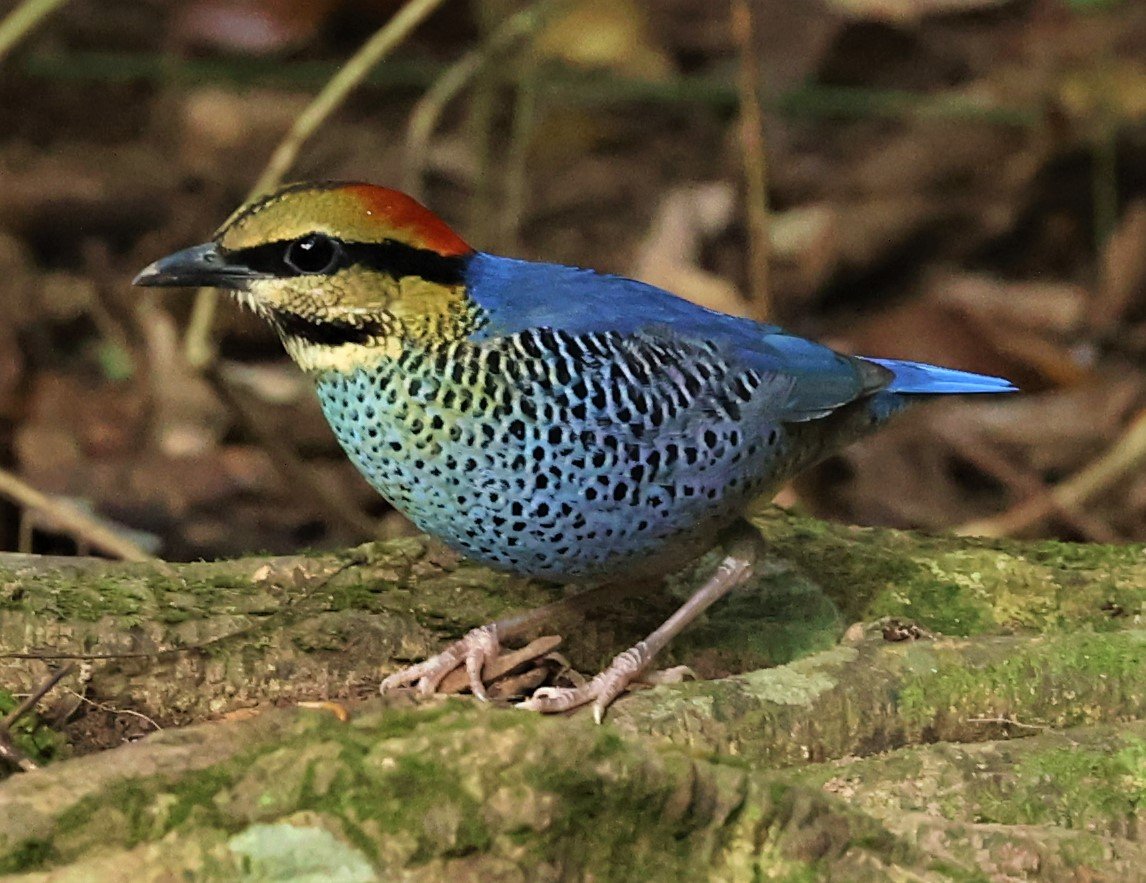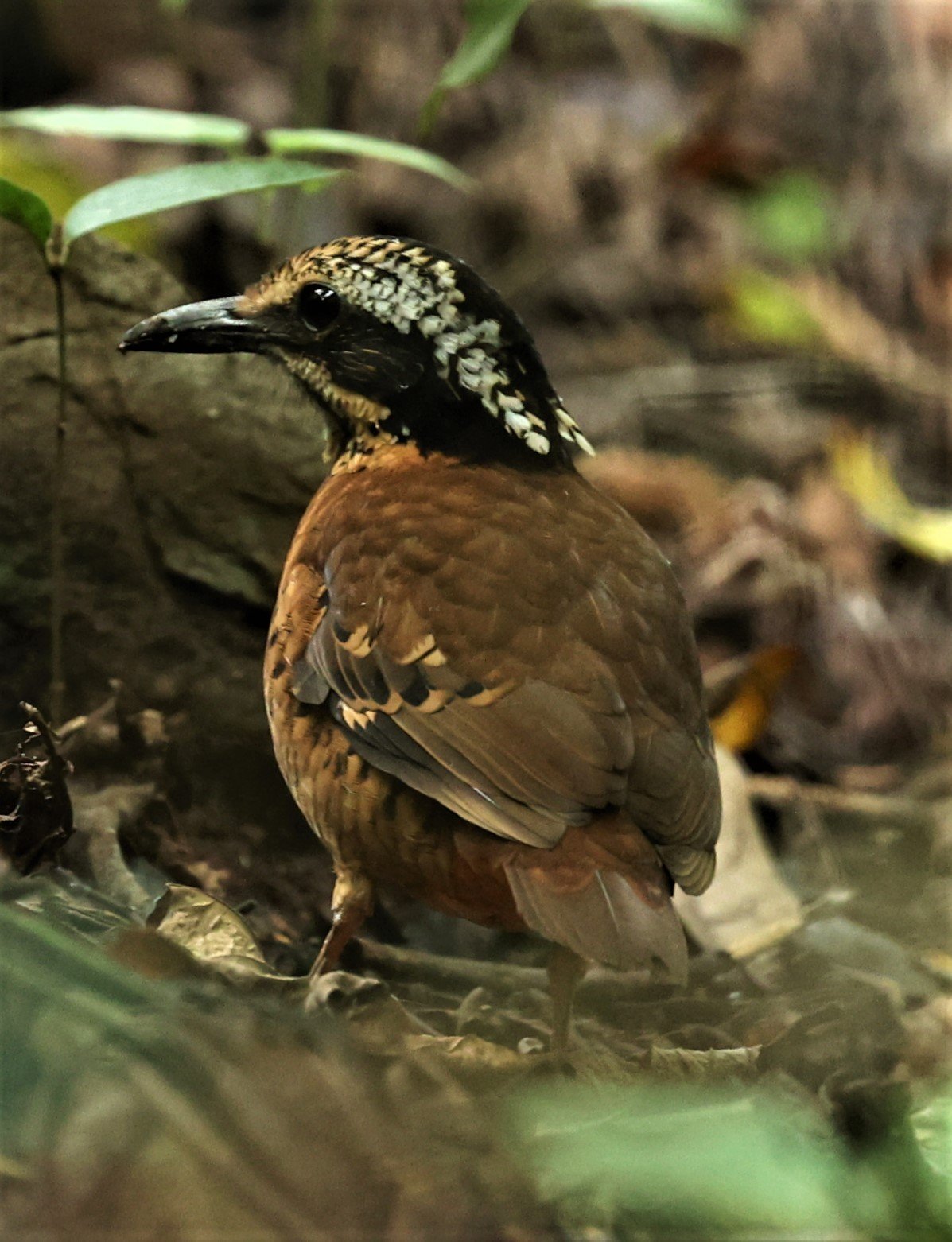
Family Pittidae, the Pitta
Hooded Pitta are sometimes found in the urban center of Bangkok
Pittas are a family, Pittidae, of passerine birds found in Asia, Australasia and Africa. There are thought to be 40 to 42 species of pittas, all similar in general appearance and habits. The pittas are Old World suboscines, and their closest relatives among other birds are in the genera Smithornis and Calyptomena. Initially placed in a single genus, as of 2009 they have been split into three genera: Pitta, Erythropitta and Hydrornis. Pittas are medium-sized by passerine standards, at 15 to 25 cm (5.9–9.8 in) in length, and stocky, with strong, longish legs and long feet. They have very short tails and stout, slightly decurved bills. Many have brightly coloured plumage.
Most pitta species are tropical; a few species can be found in temperate climates. They are mostly found in forests, but some live in scrub and mangroves. They are highly terrestrial and mostly solitary, and usually forage on wet forest floors in areas with good ground cover. They eat earthworms, snails, insects and similar invertebrate prey, as well as small vertebrates. Pittas are monogamous and females lay up to six eggs in a large domed nest in a tree or shrub, or sometimes on the ground. Both parents care for the young. Four species of pittas are fully migratory, and several more are partially so, though their migrations are poorly understood.
Four species of pitta are listed as endangered by the International Union for Conservation of Nature; a further nine species are listed as vulnerable and several more are near-threatened. The main threat to pittas is habitat loss in the form of rapid deforestation, but they are also targeted by the cage-bird trade. They are popular with birdwatchers because of their bright plumage and the difficulty in seeing them.
Blue Pitta are arguably one of Southeast Asia’s most spectacular species
The pittas are generally birds of tropical forests, semi-forests and scrub. Most species need forests with much cover, a rich understory, and leaf litter for feeding, and they are often found near waterways as well. Some species inhabit swamps and bamboo forests, and the mangrove pitta, as its name suggests, is a mangrove specialist. Several species are lowland forest specialists. For example, the rainbow pitta is not found above 400 m (1,300 ft). Other species may occur at much higher elevations, including, for example, the rusty-naped pitta, which has been found up to 2,600 m (8,500 ft). The altitudinal preferences varies in the fairy pitta across its range, it can be found up to 1,300 m (4,300 ft) in Taiwan but stays at lower altitudes in Japan. As well as natural habitats, pittas may use human-altered spaces. For example, migrating blue-winged pittas and hooded pittas use parks and urban gardens in Singapore.
Mangrove Pitta are a common resident in Thailand’s mangrove forests in the south
The greatest diversity of pittas is found in South-east Asia. Of the three genera, the large genus Pitta is the most widespread. The two species found in Africa, the African pitta and green-breasted pitta, are from this clade, as is the most northerly species (the fairy pitta) and the most southerly (the noisy pitta, Pitta versicolor). The most remote insular endemics are in this group as well, including the black-faced pitta, which is endemic to the Solomon Islands. The pittas of the clade Erythropitta are mostly found in Asia. with one species, the Papuan pitta, reaching the north of Australia. The Hydrornis pittas are exclusively Asian. Some pittas have large distributions, like the hooded pitta, which ranges from Nepal to New Guinea, while others have much smaller ones, like the superb pitta, which is endemic to the tiny island of Manus in the Admiralty Islands.
The movements of pittas are poorly known and notoriously difficult to study. Bird ringing studies have not shed much light on this. One study in the Philippines ringed 2000 red-bellied pittas but only recaptured ten birds, and only one of these recaptures was more than two months after the initial capture. Only four species of pitta are fully or mostly migratory, all in the genus Pitta: the Indian pitta, the African pitta, the fairy pitta and the blue-winged pitta. As well as these four, the northern subspecies of the hooded pitta is a full migrant. Other species make smaller or more local, and poorly understood, movements across small parts of their range, including the noisy pitta of Australia. The migration of pittas is apparently nocturnal, and pittas migrate in small loose flocks that use the same resting and foraging sites each year.
I have seen but a few of the dozens of species of Pitta. For images of what I have seen, follow the links on the images below for the larger galleries for each species.

Garnet Pitta (Erythropitta granatina) Malaysia
Blue Pitta (Hydrornis cyaneus) Female
Blue Pitta (Hydrornis cyaneus) Male
Eared Pitta (Hydrornis phayrei) Thailand
Blue-naped Pitta (Hydrornis nipalensis) Female Thailand
Blue-naped Pitta (Hydrornis nipalensis) Male Thailand
Hooded Pitta (Pitta sordida) Bangkok
Fairy Pitta (Pitta nympha) Bangkok
Malayan banded pitta (Hydrornis irena) Si Phang Nga National Park, Thailand
Mangrove Pitta (Pitta megarhyncha)
Blue-winged Pitta (Pitta moluccensis) Thailand
Indian pitta (Pitta brachyura) Sri Lanka
Malayan Banded Pitta (Hydrornis irena) Sri Phang Nga National Park (male)















